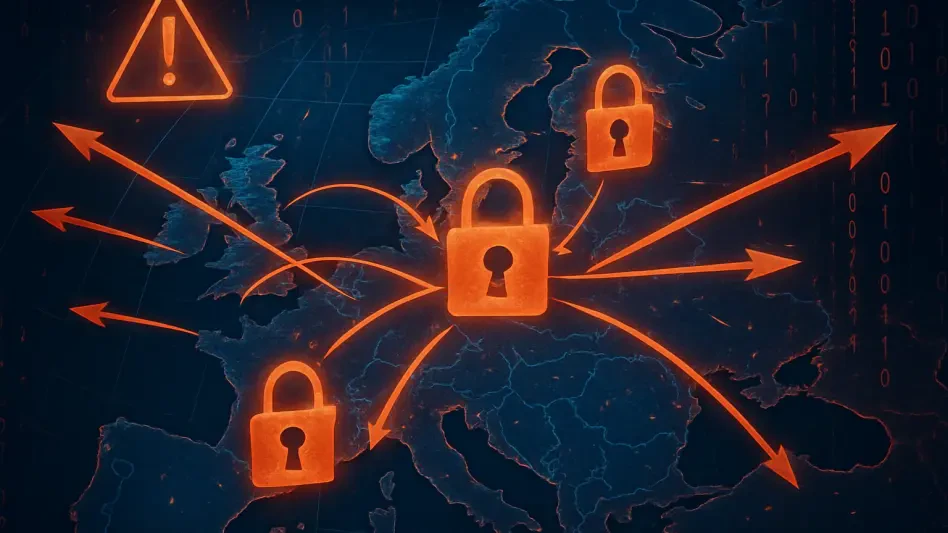In the heart of Europe, a silent battle rages—not with tanks or troops, but with code and cunning, where a single ransomware attack can paralyze a multinational corporation in under 24 hours, costing millions and shaking the foundations of economic stability. As digital assaults grow more ruthless, the continent finds itself on the frontline of an invisible war, where the stakes extend beyond technology to national security and societal trust. This unfolding crisis demands attention, as the threats lurking in cyberspace challenge the very fabric of modern life.
Why Europe’s Cyber Battlefield Matters
The digital landscape in Europe has become a high-stakes arena where cybercriminals and state actors clash with devastating precision. A staggering 22% of global cyber victims are based in this region, with major economies like the United Kingdom and Germany facing relentless attacks. The speed and scale of these incidents reveal a chilling reality: no entity, from small businesses to government institutions, is immune to the chaos unleashed by a well-executed breach. This isn’t merely a technical glitch—it’s a systemic risk that could destabilize entire industries overnight.
Understanding the gravity of this situation requires a closer look at the consequences. Beyond financial losses, cyberattacks erode public confidence in digital systems, disrupt critical infrastructure, and even influence geopolitical dynamics. With Europe positioned as a global economic powerhouse, the ripple effects of a single breach can extend far beyond its borders, impacting international trade and security alliances. The urgency to address these dangers has never been more apparent, as the continent grapples with an enemy that operates in the shadows.
The Shifting Sands of Cyber Danger
Europe’s role as a prime target for digital adversaries stems from its economic might and complex geopolitical environment. Conflicts such as the war in Ukraine and tensions in the Middle East have fueled a surge in malicious activities, with state-sponsored actors and hacktivists exploiting these flashpoints to advance their agendas. The data paints a grim picture: since early 2025, over 2,100 regional entities have been named on ransomware leak sites, signaling an alarming escalation in both the frequency and audacity of attacks.
Key nations like France, Italy, and Spain join the UK and Germany as focal points for these threats, with high-value industries such as manufacturing and technology bearing the brunt of the assault. The motivations behind these attacks vary, from financial gain sought by organized crime syndicates to strategic intelligence gathering by foreign powers. This intricate web of intent and action creates a volatile threat landscape, where the lines between criminal and political motives blur, demanding a nuanced understanding of the forces at play.
Breaking Down the Digital Menace
The spectrum of cyber risks facing Europe is as diverse as it is dangerous, with several distinct challenges standing out. Ransomware remains a top concern, with groups achieving deployment speeds 48% faster than before, striking within a mere day. This rapid execution, often targeting sectors like industrials and engineering, leaves little room for response, amplifying the damage potential across the region’s economic core.
Beyond ransomware, the commoditization of cybercrime tools has democratized malice, allowing even novice attackers to wreak havoc through underground marketplaces. Initial Access Brokers have advertised network access to over 1,400 European organizations since the start of 2025, lowering the barrier for devastating breaches. Meanwhile, state-sponsored espionage from nations like Russia, China, Iran, and North Korea focuses on defense and energy sectors, aligning with broader geopolitical aims such as undermining alliances or pilfering sensitive data. Hacktivist campaigns, often tied to global unrest, further complicate the scenario, with over 1,000 fake CAPTCHA incidents and disruptive DDoS attacks recorded in recent months, showcasing the multifaceted nature of this digital onslaught.
Insights from the Trenches
Experts on the ground describe Europe’s cyber environment as a crowded and intricate battlefield, where the pace of threats outstrips traditional defenses. One industry leader noted that the region faces a “perfect storm” of criminal innovation and state-driven aggression, a sentiment echoed by many in the field. This perspective highlights the pressing need for adaptive strategies to counter an enemy that evolves by the hour, leveraging both technology and global events to maximize impact.
Real-world impacts bring these warnings to life, such as the case of a prominent European manufacturer crippled by ransomware in a single night, resulting in millions in losses from downtime alone. Such incidents, coupled with data showing a sharp rise in victim numbers and targeted strikes on NATO-aligned states, underscore the tangible toll of these threats. The convergence of financial and political motives in these attacks reveals a broader challenge: protecting not just data, but the very stability of interconnected systems that define modern society.
Building a Stronger Defense
Confronting this accelerating digital enemy requires decisive, forward-thinking measures across both public and private sectors. Adopting intelligence-led cybersecurity, powered by AI tools and human expertise, stands as a critical step to predict and neutralize threats before they materialize, especially given the shrinking windows for ransomware response. Collaboration with international law enforcement to dismantle underground marketplaces and disrupt Initial Access Brokers offers another vital tactic, striking at the root of the cybercrime ecosystem.
Tailoring defenses for critical industries like manufacturing and technology is equally essential, ensuring robust safeguards for intellectual property and infrastructure. Additionally, preparing for geopolitical triggers by monitoring global conflicts and bolstering resilience during tense periods can mitigate the risks posed by state-backed and hacktivist attacks. These strategies collectively form a roadmap to fortify Europe’s digital frontiers, emphasizing proactive vigilance over reactive patchwork solutions in an era where hesitation can prove catastrophic.
Reflecting on the Battle Fought
Looking back, the struggle against cyber threats in Europe unfolded as a relentless test of resilience and innovation. Each attack, from rapid ransomware strikes to calculated state espionage, exposed vulnerabilities that demanded urgent attention. The stories of devastated manufacturers and the stark statistics of victimized entities served as sobering reminders of the high stakes involved. Yet, they also ignited a collective resolve to adapt and overcome.
Moving forward, the path was clear: Europe had to prioritize intelligence-driven defenses, leveraging cutting-edge technology and global cooperation to stay ahead of adversaries. Strengthening critical sectors and anticipating geopolitical flashpoints emerged as non-negotiable imperatives. By investing in these areas, the continent could transform past lessons into a fortified future, ensuring that the digital warzone became a domain of security rather than chaos.








